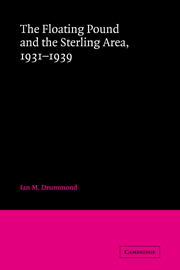Book contents
- Frontmatter
- Contents
- Preface
- 1 Introduction: the sterling area in the 1930s
- 2 Sterling and the rupee
- 3 The Canadian debate over money and exchanges, 1930–1934
- 4 South Africa, sterling, and the gold standard, 1931 and thereafter
- 5 Australia and New Zealand, 1930–1939
- 6 Monetary preparations for the World Economic Conference
- 7 United Kingdom policy at the World Monetary and Economic Conference
- 8 Talking about exchange stabilization, autumn 1933 through June 1936
- 9 The Tripartite Agreement of 1936
- 10 Intergovernmental conversations and the management of sterling, 1936–1939
- 11 Conclusion: the significance of sterling
- Notes
- Index
1 - Introduction: the sterling area in the 1930s
Published online by Cambridge University Press: 07 October 2011
- Frontmatter
- Contents
- Preface
- 1 Introduction: the sterling area in the 1930s
- 2 Sterling and the rupee
- 3 The Canadian debate over money and exchanges, 1930–1934
- 4 South Africa, sterling, and the gold standard, 1931 and thereafter
- 5 Australia and New Zealand, 1930–1939
- 6 Monetary preparations for the World Economic Conference
- 7 United Kingdom policy at the World Monetary and Economic Conference
- 8 Talking about exchange stabilization, autumn 1933 through June 1936
- 9 The Tripartite Agreement of 1936
- 10 Intergovernmental conversations and the management of sterling, 1936–1939
- 11 Conclusion: the significance of sterling
- Notes
- Index
Summary
This opening chapter sketches the structure of the sterling area from the collapse of the gold standard in 1931 to the outbreak of war in 1939. It describes the chief institutions and their interactions and presents some archival evidence about attitudes and policies in the United Kingdom during the critical months of 1931–2 and at the Ottawa Conference in the summer of 1932. The material serves as an introduction to the more detailed discussion in Chapters 2 through 10.
Chapters 2 through 5 examine the routes by which India, South Africa, and Canada did or did not adhere to sterling after September 1931 and trace some aspects of the relationship between sterling and the economies of Australia and New Zealand. These chapters are meant to provide a survey of the relationship between sterling and the more important Empire currencies. In Chapters 6 and 7 we turn to the World Monetary and Economic Conference of 1933 – the London Conference that was called by the League of Nations in response to Anglo-American initiatives. Concentrating on the monetary side of the meeting, we first survey the formulation of policy in London and the defense of that policy in various international arenas, then treat the discussions with France and America before and during the conference, and finally examine the role of the Empire governments with respect to Britain's private initiatives and her public stance.
- Type
- Chapter
- Information
- The Floating Pound and the Sterling Area1931–1939, pp. 1 - 27Publisher: Cambridge University PressPrint publication year: 1981

